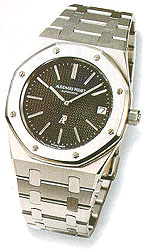The Audemars Piguet Royal Oak The year is 1972, the place, the annual timepiece fest in Basel, Switzerland, where companies show off their latest models to store buyers and the watch-loving public. Audemars Piguet, the high-end Swiss watch company, is displaying in its booth window a new luxury watch. The year is 1972, the place, the annual timepiece fest in Basel, Switzerland, where companies show off their latest models to store buyers and the watch-loving public. Audemars Piguet, the high-end Swiss watch company, is displaying in its booth window a new luxury watch.
Then he laughs. What's so funny? Just this: the watch, called the Royal Oak, is made of steel - plain, plentiful, and above all, cheap. The only gold in the watch is in the tiny 21-karat rotor that winds the automatic movement. Thousands of Swiss francs for a steel watch? During an oil crisis, no less? Ha. Fast forward to the 1990s. The Royal Oak has become Audemar's flagship model, the pride and joy of one of the Swiss watch industry's most prestigious brands. The company offers it in myriad variations: with complications, in a rainbow of dial colors, and even with solid-gold cases. (The watch is named after a series of steel-clad British Royal Navy ships whose octagonal portholes inspired the watch's bezel.) But that's not the half of it. Walk through the Basel watch exhibition halls these days and you'll see, sprouting like saplings everywhere, steel watches from the most expensive Swiss brands. Like the Royal Oak, they cost thousands of dollars. But now no one is laughing.
It was 1960, the start of the space age. The work going on in the building, we're meant to imagine, was the development of a new space-age watch. For a year, Bulova had been working overtime to build a watch using the same type of mechanism: one powered by electricity, and using as its time base, or oscillator, a tiny Y-shaped piece of nickel alloy. (It was called a "tuning fork" because it hummed as it vibrated.) On Oct. 25 Bulova presented its watch to the world. Never had such hoopla surrounded a watch introduction. The lauch was accompanied by "the most extensive publicity, advertising and sales promotion effort ever devoted to the initial merchandising of a single timekeeping product," says the company's 1961 annual report. An no wonder. Thanks to its tuning fork oscillator, the Accutron was the most accurate watch of its time, representing a quantum leap over traditional mechanical watches. Thank to its transistor, it was also the first truly reliable battery-powered one. The Accutron was an instant success, and its popularity continued to grow thorough the decade and beyond. By 1971 it was available in 110 different models and had become the best-selling $100-plus watch in the world. |
 If you're of a certain age, you're bound to feel a twinge of nostalgia when you glance at Bulova's brochure for its original Accutron watch. On the cover is a sketch of Bulova headquarters, a streamlined building exuding a kind of cosmic glow against the night sky. Huge stars shine above, looking close enough to reach in a spaceship. In the parking lot, cars with Batmobile-like fins, parked in darkness, hint at some top-secret, around-the-clock project underway inside.
If you're of a certain age, you're bound to feel a twinge of nostalgia when you glance at Bulova's brochure for its original Accutron watch. On the cover is a sketch of Bulova headquarters, a streamlined building exuding a kind of cosmic glow against the night sky. Huge stars shine above, looking close enough to reach in a spaceship. In the parking lot, cars with Batmobile-like fins, parked in darkness, hint at some top-secret, around-the-clock project underway inside.
